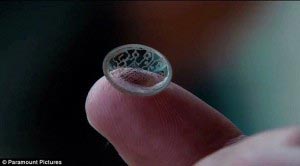Samsung researcher Jang-Ung Park thinks he can make computers less intrusive and annoying by mounting them on contact lenses rather on a pair of glasses the way Google has done.
“Our goal is to make a wearable contact-lens display that can do all the things Google Glass can do,” said Jang-Ung Park, a chemical engineer leading one of the Samsung research groups.
Park’s team mounted an LED on off-the-shelf soft contact lenses and wired them using a newly developed transparent conductive material to transmit signals to the LED. They tested the lens’s wearability on rabbits which have eyeballs of about the same size as humans’. The creatures showed no signs of irritation after wearing the lenses for five hours.
The most difficult aspect of building the prototype contact lens display was creating a material that is both transparent and conductive enough to serve as the eletronic medium. Park worked with Sung-Woo Nam of the University of Illinois at Urbana-Champaign to sandwich silver nanowires between sheets of graphene. The resulting composite is far more conductive than either material alone and achieved resistance of only 33 ohms per square, well within the industry standard of 50 ohms of resistance for a transparent conductor. It is also highly transparent, letting through 94% of visible light. To make the conductive sheets the team deposited liquid solutions of the nanomaterials on a spinning surface, such as a contact lens, at low temperatures.
The electronic contact lenses may also serve as a biosensor, says Nam. By continuously sampling the chemistry of the eye the lenses could monitor the wearer’s health without invasive or cumbersome tests.
Jang-Ung Park is a professor of the School of Nano-Bioscience and Chemical Engineering at UNIST.



